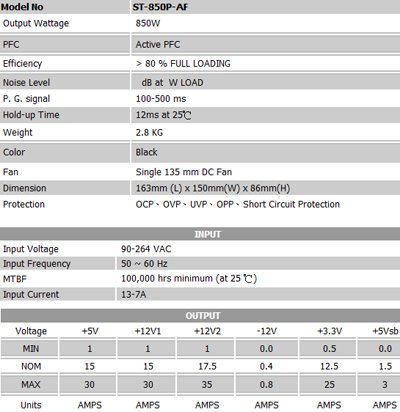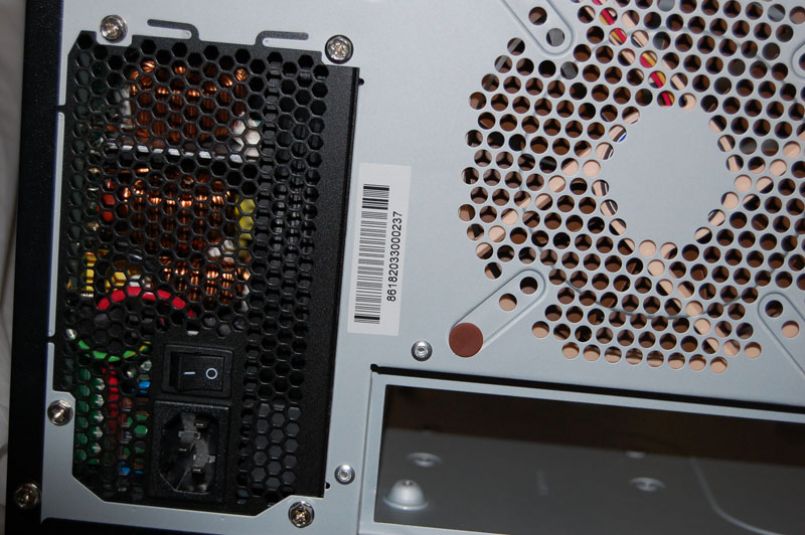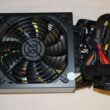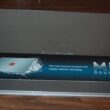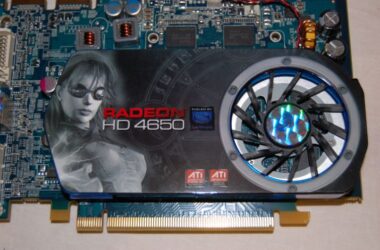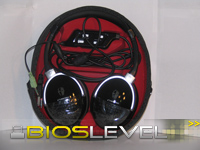Introduction
Most of today’s high-end videocards follow a similar trend: more speed means more power needed. Of course, this is also true for numerous other components as well, but videocards being the most greedy. This trend leads end users to needing more powerful power supplies, particularly when utilizing SLI or CrossFire in a system.
Seventeam recently sent the recently released ST-850P-AF 850 watt powersupply. Seventeam has been in the switch powersupply industry since 1986, so the company has the experience required to build a reliable powersupply. However, Seventeam’s products aren’t the easiest to find in the United States.
Much like NorthQ’s Black Magic powersupply I previously looked at, the ST-850P-AF also features a 135mm cooling fan. The biggest different between these two units aside from individual components is that the ST-850P-AF does not feature modular connectivity. Will the stability of the ST-850P-AF prove that the unit should be carried in more U.S. retailers such as NewEgg? Or will the powersupply not quite live up to my expectations?
Packaging & Appearance
Seventeam’s packaging may be some of the most informative packaging I’ve ever seen. The front of the box merely has the product’s logo and series name on it, with a few small features thrown in as well.
The rear lists the unit’s features in several different languages.
Seventeam makes use of three of the small sides of the box as well. One side shows the available connectors and electrical loads, while the opposing side shows fan usage and power consumption compared against other powersupplies.
The front flap lists a few more features of the unit, as well as lists the available connection types.
Inside the box, the powersupply is protected by two pieces of foam fitted to it. The cables are wrapped neatly next to it, and a soft fabric Seventeam bag that holds the AC cable is also included.
The unit and cable sleeving are black, as are the individual cable connections. One thing I didn’t necessarily like about the initial appearance of the unit was the fact the the cable sleeving only extended as far as the first connector on each cable. Afterwards, there was about six to seven inches of non-sleeved cabling.
The back of the power supply is once again a mesh, a trend I’ve seen in several recently released power supplies.
The underside of the unit is a massive 135mm fan, meant to effectively cool the powersupply and remain reasonably silent. This is the big advantage over one or two 80mm fans in a powersupply.
Specifications
- ATX 12V V2.2 version compatible
- Output Capacity: 850Watts Continuous
- Dual +12V rails for newest system: Maximum output current 65A
- Standard compatibility: Support Intel Quad Core and AMD Dual Core CPU
Support Nvidia SLI and ATI Crossfire VGA Card - Build in STNC fan control
- 100% Hi-Pot test
- Active PFC
- High Efficiency>80%
- Build in Japanese Capacitors
- The Doubles Forward design structure
- Big heat sink thickness the 5mm
- 135mm Low-Noise Fan
- Dimension: 163 * 150 * 86mm
- Life expectancy: MTBF >100,000 hours
- Multiple Protections Function:(OCP?OVP?UVP?OPP)
- Safety Approvals:CE, TUV, CB, FCC, CUL and BSMI
- 80PLUS BRONZE and Certified
Unlike some newer high-powered powersupplies, the ST-850P-AF only has two 12v rails, rather than the four. In the case of three- or four-way CrossFireX, it may prove to be a stability issue depending on how much power the cards draw.
Specifications
Benchmark Setup
Since my typical benchmark system resides in a MicroFly micro-ATX case, I’ll be using my workstation to test the Seventeam ST-850P-AF. The workstation features three Radeon HD4850-class video cards in CrossFireX, as well as a quad-core Intel CPU.
| Component | Part |
|---|---|
| Case | Thermaltake M9 |
| Motherboard | ASUS P5E64 WS Professional |
| CPU | Intel Core2 Quad Q6600 @ 2.4GHz |
| RAM | 2GB Patriot DDR3-1666 |
| Hard Drives | 2x Western Digital 36GB Raptors 2x Seagate 160GB SATA2 2x Maxtor 250GB SATA2 1x Hitachi DeskStar 7K1000 1TB |
| Video Cards | Sapphire Radeon HD4850 Sapphire Radeon HD4850 Toxic Palit Radeon HD4850 |
| Sound | Creative SoundBlaster Audigy |
| Misc. | HighPoint RocketRAID 3120 |
| Operating Systems | Windows Vista Business 32-bit / Gentoo Linux 2008.0 64-bit |
Of course, my hope is that I have enough hardware to properly stress-test the ST-850P-AF.
Installation
As with most power supplies, installation was quick and easy. After securing the power supply to the case, I connected the mother board connections.
Since the unit isn’t modular, I was stuck with all the cables that came with it. That means I actually have to find somewhere to hide the unused cables.
After it looked satisfactory, I plugged the ST-850P-AF to the wall’s AC outlet and switch the power supply to the ON position. The computer came to life… silently.
Performance
I’ll be utilizing OCCT to measure the voltages of the various connections. I’ll also verify these results with lm_sensors in Linux. Ideally, I’d like to monitor the voltages in Linux, but there isn’t yet an application for Linux that will stress test the system and graph the results.
The ST-850P-AF is 80PLUS certified, meaning that it is 80% or more efficient in the conversion of AC power to DC power. For the review, I’d like to look at the unit’s performance in a workstation setting. With a workstation, I believe it’s customary for the machine to draw large amounts of power regardless of how efficient a power supply may be. Of course, the other reason I could be neglecting this section is because of my trusty Kill-a-Watt fried during a storm and no longer measures amperage for me!
Let’s look at how the ST-850P-AF performed over the course of an hour with the CPU being run close to 100%. First, the CPU’s VCore:
Follow this with the 3v line:
Next, I have the 5v line:
Lastly, the 12v line.
Final Thoughts & Conclusion
Using lm_sensors in Linux provided similar results. The base voltages remained the same, but I the CPU utilization in Linux while compiling KDE was slightly lower than that of OCCT’s. Regardless, it seems that all goes well in the land of voltage readings in Linux.
Despite the ST-850P-AF only having two 12v rails, the unit does perform reasonably well. All voltages stayed reasonably within their respective limits during the stress test. To take things further, I engaged CrossFire between my three Radeon HD4850 cards and started a game of Unreal Tournament 3 with 30 bots and full graphics. While the CPU didn’t quite hit the 90% mark, I know the videocards were pulling some extra power and running at full load. After playing for about 30 minutes, the system remained stable.
Some small improvements I’d like to see made include the addition of two more 12v rails for improved performance, as well as fully-sleeved cables.
Overall, Seventeam has a fantastic product in the ST-850P-AF. Plenty of power, relatively compact, and great performance. While many of Seventeam’s products are hard to come by in the states, I can never hope enough that NewEgg continues to pick up worthwhile brands such as Seventeam in the future.
Pros
- Strong Voltage Regulation
- Long cables
- Plenty of connections
- Small size compared to some high-wattage units
- 135mm fan runs reasonably silent
Cons
- Non-sleeved cables are a little unattractive
- Hard to find in North America yet!
- Only two 12v rails
- Not modular














